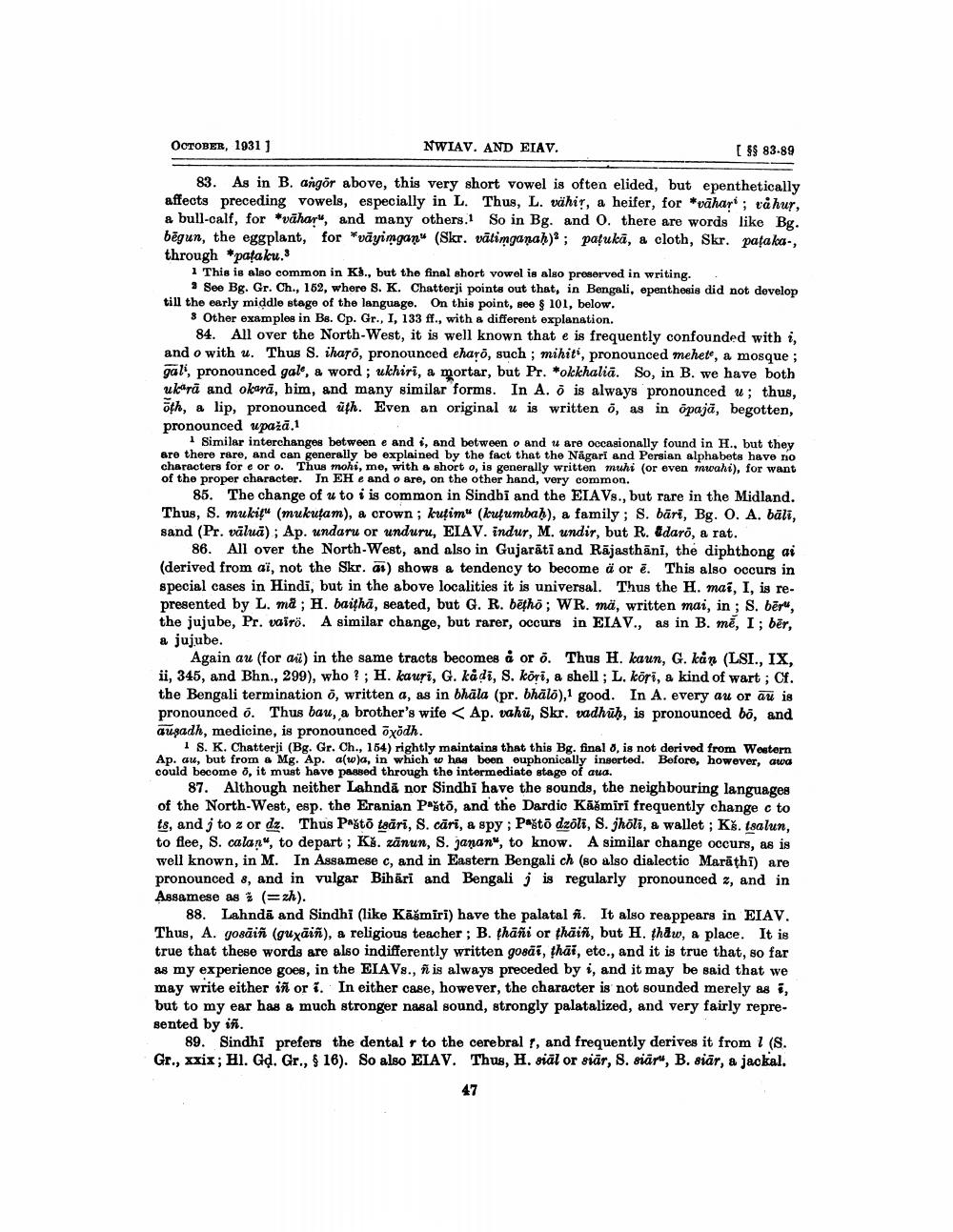________________
OCTOBER, 1931)
NWIAV. AND EIAV.
[ $$ 83-89
83. As in B. angör above, this very short vowel is often elided, but epenthetically affects preceding vowels, especially in L. Thus, L. vähir, a heifer, for *vāhar; råhur, a bull-calf, for *vāhar", and many others. So in Bg. and O. there are words like Bg. bēgun, the eggplant, for "vāyimgan" (Skr. vātimganah); paukā, a cloth, Skr. pataka, through *pataku.
1 This is also common in K., but the final short vowel is also preserved in writing. .
3 See Bg. Gr. Ch., 162, where S. K. Chatterji points out that, in Bengali, epenthesis did not develop till the early middle stage of the language. On this point, see $ 101, below.
8 Other examples in Bs. Cp. Gr., I, 133 ff., with a different explanation.
84. All over the North-West, it is well known that e is frequently confounded with i, and o with u. Thus S. ihaso, pronounced eharő, such ; mihit, pronounced mehete, a mosque ; gali, pronounced gale, a word ; ukhiri, a mortar, but Pr. *okkhaliā. So, in B. we have both ukarā and okarā, him, and many similar forms. In A. 7 is always pronounced u; thus, oth, a lip, pronounced uth. Even an original u is written 7, as in opajā, begotten, pronounced upažā.1
Similar interchanges between e and i, and between 0 and 1 are occasionally found in H., but they are there rare, and can generally be explained by the fact that the Nagari and Persian alphabets have no characters for e or o. Thus mohi, me, with a short o, is generally written muhi (or even mwahi), for want of the proper character. In EH e and o are, on the other hand, very common.
85. The change of u to i is common in Sindbi and the EIAVs., but rare in the Midland. Thus, S. mukiť (mukutam), a crown; kutim" (kutumbah), a family ; S. bāri, Bg. O. A. bāli, sand (Pr. vāluă); Ap. undaru or unduru, EIAV. indur, M. undir, but R. &daro, a rat.
86. All over the North-West, and also in Gujarāti and Rājasthāni, the diphthong ai (derived from ai, not the Skr. 21) shows a tendency to become ä or ē. This also occurs in special cases in Hindi, but in the above localities it is universal. Thus the H. mai, I, is represented by L. må; H. baitha, seated, but G. R. bētho; WR. mä, written mai, in; S. bēr", the jujube, Pr. vairo. A similar change, but rarer, occurg in EIAV., as in B. mē, I; bēr, a jujube.
Again au (for ai) in the same tracts becomes å or 7. Thus H. kaun, G. kàn (LSI., IX. ii, 345, and Bhn., 299), who ?; H. kauri, G. kådi, S. kori, a shell ; L. köri, a kind of wart; Ch. the Bengali termination o, written a, as in bhāla (pr. bhälö),1 good. In A. every au or au is pronounced o. Thus bau, a brother's wife < Ap. vahū, Skr. vadhūh, is pronounced bo, and ausadh, medicine, is pronounced õxõdh.
IS. K. Chatterji (Bg. Gr. Ch., 154) rightly maintains that this Bg. final 0, is not derived from Western Ap. au, but from a Mg. Ap. a(w)a, in which w has been euphonically inserted. Before, however, awa could become o, it must have passed through the intermediate stage of aua.
87. Although neither Lahndā nor Sindhi have the sounds, the neighbouring languages of the North-West, esp. the Eranian Pešto, and the Dardic Kašmiri frequently change c to ts, and j to z or dz. Thus Pašto taäri, S. cari, a spy ; Pašto dzoli, S. jhõli, a wallet ; Kš. tsalun, to flee, S. calan", to depart; Kš. zānun, S. janan", to know. A similar change occurs, as is well known, in M. In Assamese c, and in Eastern Bengali ch (so also dialectic Marathi) are pronounced 8, and in vulgar Bihāri and Bengali j is regularly pronounced 2, and in Assamese as X (=zh).
88. Lahndā and Sindhi (like Kāšmiri) have the palatal ħ. It also reappears in EIAV. Thus, A. gosāiñ (gujāiñ), a religious teacher; B. thañi or thāiñ, but H. thaw, a place. It is true that these words are also indifferently written gosãi, thai, etc., and it is true that, so far as my experience goes, in the EIAVs., ñ is always preceded by i, and it may be said that we may write either iñ or i. In either case, however, the character is not sounded merely as i, but to my ear has a much stronger nasal sound, strongly palatalized, and very fairly represented by in.
89. Sindhi prefers the dental to the cerebral 1, and frequently derives it from 1 (S. Gr., xxix; Hl. Gd. Gr., $ 16). So also EIAV. Thus, H. siāl or siar, S. siārus, B. siār, a jackal.




